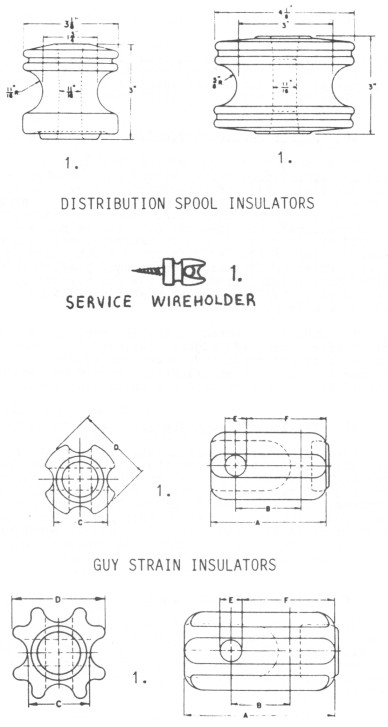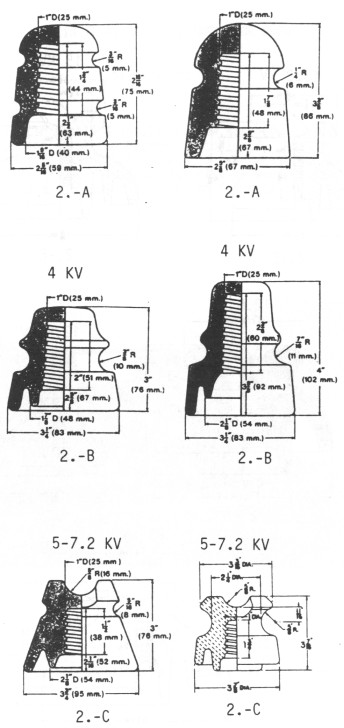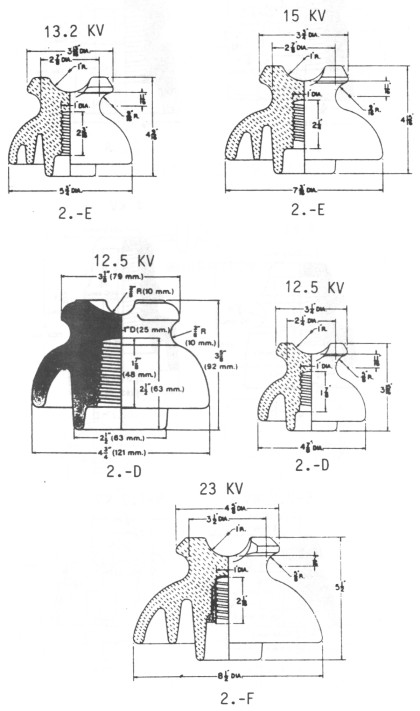Applications of Electrical Porcelain Power Insulators (Part one of two parts)
by Robert L. Winkler
Reprinted from "Crown Jewels of the Wire", July 1987, page 37
Before the porcelain insulators adorning the shelves or cabinets of most
insulator collectors took up their present retirement positions, they served
another very real and demanding purpose. Many of the insulators collectors now
prize due to age, color, marking, historical style, etc. actually performed a
service, which if fully understood and appreciated, would far out distance any
of their "collectible qualities" we could think of.
For 50, 60, 70 years and sometimes more, many of our favorite specimens
served the power, light and railway companies in regular operation. They sat on
a pole, often on the same pin, for their entire service life through all the
various weather and contamination spectrums the decades could throw at them.
They also had to bear-up under the electrical and mechanical loads they were
designed for and sometimes more.
Now many of these "workhorses of the wire" are in proud collections
across the country. Over the years I have run onto many collectors who, outside
of what they have read in collector's books or the like, have very little
knowledge of the applications of their insulators as to the types and voltages
of the lines they served upon.
I will try in the following paragraphs to give a little basic information on
the classes of insulators as to the type of systems (transmission or
distribution) they served on and the general voltage levels for each.
I hope in some small way this information will enhance the knowledge of the
collectors as to the "real life" roll of their insulators, which to me
has been one of the important and fascinating parts of the insulator hobby in
general.
NOTE: All voltages stated here are 60 Hz (cycles) AC (alternating current). KV
kilovolt or 1000 volts, example: 69 KV = 69,000 volts.
(Reference drawings to this article are on the pages following the article.)
1. SPOOL and GUY STRAIN INSULATORS
These are generally the lowest voltage class of line insulators used in Secondary
Distribution systems. The "rack" or "clevis" spool insulators and the
"service wireholder" insulators, as found on most house service drops,
are in use on lines from 120 to 600 volts. They are used extensively in overhead
static and ground lines on transmission systems and often carry the neutral
conductor on primary distribution systems.
The guy strain insulator is generally employed in down-guy cables to prevent
any possible leakage of current from power lines to reach the ground largely as
protection to any person who might come in contact with the guy cable. Most
companies install two of these units, a proper distance from the pole and the
ground in each guy cable, for the best protection.
Guy strains can be used in live line service, usually at secondary
distribution voltage levels, such as a "break" or "section"
insulator in series street lighting circuits.
2. PIN TYPE INSULATORS
2A. Single Petticoat Side Groove
At the present tine, I know of no U. S. manufacture offering this style as
part of their catalog line. For the most part, these units saw service in the
past on telephone and telegraph lines. Some were and still can be found on low
voltage 110-440 volt signal power lines for railway signal systems.
2B. Double Petticoat Side Groove - 4 KV
For many years these were the standard pin insulators for Secondary
Distribution and Lower Voltage Primary Distribution systems across the U.S. Voltages from 120 - 4,000 volts were common on lines
using these insulators and many are in service today. Many utilities have in
recent years discontinued the use of these insulators in favor of top-tie
(saddle groove) styles due to the larger conductors of modern systems plus the
greater security of top-tie insulators for maintaining the cable in position.
2C. Double Petticoat Top-Tie - 5 to 7.2 KV
This is the smaller range of these insulators generally found on Lower
Voltage Primary Distribution systems.
Most recent units have the radio proof glaze coatings as do most of the
insulators (pin type) from this class up in voltage to 69 KV since the 1940's.
2D. Double Petticoat Top-Tie - 11 to 12.5 KV
This style is one of the standard units for Primary Distribution lines around the country,
almost the "Hemingray #42 of porcelain". Several utilities have
standardized to the point where these units are the only pin types they stock
for new construction. These insulators are used in both single phase service at
7.2 KV (1 primary and 1 neutral line) and three phase service at 12.5 KV (3
primary lines and a neutral line). Note: To determine the single phase voltage
of three phase primary lines, divide the voltage by 1.73. For example, 12.5 KV
(three phase) divided by 1.73 = 7.2 KV (single phase).
It should be noted that, in many cases, older units often carried higher
ratings than the same general size and style made after the 1940's or 1950's. In
general, these classifications should be considered 5 to 10 KV on the high side
for units made before 1930.
2E. Triple Petticoat Top-Tie - 13.2 to 15 KV
These Primary Distribution insulators are
generally widely used across the U. S. In some cases, they will be found on 12.5
KV systems with requirements for higher rated insulators due to contamination
problems. In some coastal areas, 7.2 KV primaries are insulated with 45 KV rated
multiparts! The larger range of these with the 7 to 7-3/8 inch diameter was at
one time rated at 23 KV. One inch threaded pins are standard and the 1-3/8 inch
pin is optional.
2F. Triple Petticoat Top-Tie - 20 to 23 KV
These large units are fairly recent arrivals. They have been used on a few
34.5 KV High Voltage Primary Distribution systems (19.9 KV single phase) and as contamination insulators on
lower voltage systems. They usually come with a stamped zinc thimble for one
inch standard pins.

Large Image (75 Kb)

Large Image (105 Kb)

Large Image (101 Kb)
| 